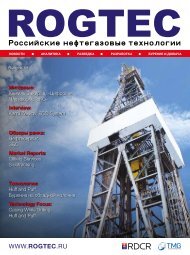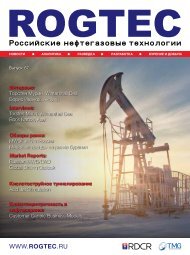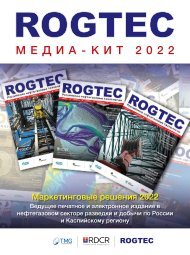ROGTEC Magazine Issue 61
Russian Oli & Gas Magazine
Russian Oli & Gas Magazine
You also want an ePaper? Increase the reach of your titles
YUMPU automatically turns print PDFs into web optimized ePapers that Google loves.
SMART WELLS
комплекса ПГИ (PLT). Однако данное оборудование
позволяет выполнять непрерывный дистанционный
мониторинг работы скважины в течение
длительного периода (месяцы или годы).
В результате анализа и систематизации
результатов, полученных с помощью
распределенных СИИС к 2019 г., а также
на основе цифрового моделирования на
термогидродинамических симуляторах, были
сделаны теоретические обоснования по основным
исследуемым забойным параметрам (давление,
температура, фазовый расход). Это позволило
для распределенных и точечно-распределенных
СИИС разработать необходимую методическую [2]
и нормативную (М-01.05.01.05-01. Методические
указания по проведению скважинных
исследований (ПГИ). – 2018 г.; М-01.05.02.01-
01. Методические указания по проведению
скважинных исследований (ТИ и ГДИС). – 2017
г.) базу с целью их последующего широкого
внедрения на месторождениях компании «Газпром
нефть». Кроме того, были сформулированы
рекомендации и временные ограничения для
прошедших апробацию высокотехнологичных
СИИС [3]. Таким образом, задача создания на
месторождениях «Газпром нефти» современной
цифровой СИИС глубинного геомониторинга
при разработке нефтяных залежей, не- смотря
на реализацию отдельных этапов с видимым
экономическим эффектом, по-прежнему остается
в одной из первоочередных задач программы
технологического развития. За 2012–2018 гг.
были достигнуты следующие результаты: –
изучены и отобраны на мировом рынке наиболее
практичные и экономичные глубинные СИИС;
– проведена поэтапная апробация СИИС на
объектах компании с учетом разных геологоэксплуатационных
условий разрабатываемых
активов; – разработано методико-алгоритмическое
обоснование; – обоснованы требования к
созданию на месторождениях компании
опорных сетей стационарного геомониторинга.
Следует отметить, что на момент начала работы
специалистов «Газпром нефти» над данным
комплексным проектом в России не было
готовых технологических решений, а стоимость
зарубежных разработок была значительно
выше стоимости решений, в настоящее
время рекомендованных к применению на
объектах «Газпром нефти». Значительная часть
измерительно- го инструментария и оборудования
была кардинально изменена компаниямиподрядчиками
по скорректированным техническим
заданиям, в том числе и в плане снижения их
стоимости.
upon bottomhole pressure and skin-factor data
obtained by permanent wellbore sensors. In 2018 on
a monthly basis approximately 22 wells were subjected
to re-fracking; no-good candidate wells (statistically
16%) were excluded and replaced with wells selected
upon well testing data obtained by permanent
wellbore sensors. On average re-fracking at current
field resulted in 10 tons/day of production increase,
consequently effect of permanent wellbore sensors
comprised 1.35% of total oil production.
2. For the other assets of Gazprom Neft only the
economical effect which measured in an incremental
annual oil production due to (a) component mentioned
above was accounted for. Total annual net cash flow
resulted from complimentary produced oil due to
development and implementation of the system for
remote wellbore geomonitoring amounted to 2.17 bln
RUR. This calculation can be considered as being a
conservative estimation because it doesn’t consider
neither the operation costs savings nor the indirect
effects of single-gauge wellbore sensors installation.
Prospects for future implementation of the
remote monitoring system
Currently most Russian oil companies produce assets
with unconventional reserves. Comprising of 50% and
more of their total production. Smart completions of
hi-tech wells and remote acquisition of bottomhole
data provide significant benefits due to operating cost
reduction and oil production savings. Further efficiencies
increase with wireline logging and well testing at hitech
horizontal wellbores together with the overall
efficiency increases with the development of assets
with unconventional reserves which can be attributed
to conversions from single-run wellbore logs to longterm
monitoring with permanent sensors distributed
all over the wellbore. At present the most advanced
technology that utilize fiber optic allowing remote
temperature measurements within the whole well profile
and by single-gauge-distributed systems based on
fiber Bragg grating. Single-gauge-distributed indicatorbased
wellbore systems, as proven in their field tests
aren’t reliable enough and seem to require a significant
improvement.
In order to implement distributed permanent wellbore
sensors within a wide range of oilfields, application
guidelines and technical requirements being created as
part of the Corporate Technological Strategy program.
Upon completion of this stage it’s expected to form
guidelines for implementing this technology in any
horizontal well being drilled. As a way forward innovative
wellbore sensors are under consideration including
distributed hot-wire anemometry on a basis of fiber optic
www.rogtecmagazine.com
ROGTEC
65















